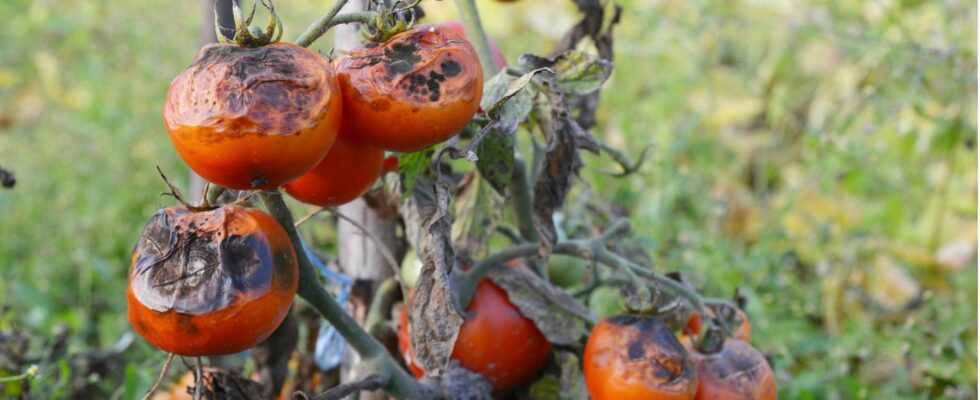Late blight is the most common tomato disease. Hardly any garden is spared from it, especially in wet summers the danger is great. How tomatoes can be protected and what helps against the fungal disease.
Red or yellow, oval or spherical, large or small – the Germans love their tomatoes. In summer, tomato plants sprout everywhere on balconies and in gardens, in planters and vegetable beds. And there is probably nothing that proud hobby gardeners fear more than late blight, scientifically Phytophthora infestans.
The stubborn fungal disease, which affects not only tomatoes but also other nightshade plants such as potatoes, is particularly common in humid summers. Because like most types of mushrooms loves too Phytophthora infestans warm and humid conditions. In such conditions, the spores can spread wonderfully on the plants.
The fungal spores are transmitted by wind and rain. Even when watering, the fungus, whose spores are in the soil around the tomato plants, can get to the stems and lowest leaves through splashing soil. The plants are already infected.
Recognizing late blight and late blight on tomato plants
A clear sign that a plant is affected by late blight are brown spots on the leaves and oblong dark spots on the stems. A delicate white layer of fungus can also form on the underside of the leaves. As the disease progresses, the leaves turn black, begin to wilt, and eventually die. The spores survive in the soil.
The fruits themselves develop hard spots, turn brown and rot from the base of the stalk. Larger, squishy-brown spots sometimes also appear on affected tomatoes.
A very similar pattern of damage is shown in what is known as fruit and stem rot, scientifically Didymella lycopersici. However, this fungal disease begins at the base of the stem as black, sunken bark tissue.
Diagnosis of brown rot: what to do now
If you have already discovered the first brown spots on the leaf edges and stems of your tomato plants, you must act immediately. That means: Quickly get rid of the affected leaves and stems and, in the case of a severe infestation, the whole plant as well.
Thin out the remaining foliage generously: Cut off the leaves of the tomato plants below the first tomato panicles. You can also reduce the leaf mass above – this allows the plant to dry out faster and makes it more difficult for the fungus to establish itself.
Once you have removed all infested parts of the plant, they should be disposed of directly in the organic or residual waste. Under no circumstances should the plants end up on the compost – this would create a breeding ground for the fungus in your own garden. Once the work is done, tools should be thoroughly cleaned with boiling water and ideally disinfected with vinegar or alcohol.
If late blight is already very advanced, there is only one thing left to do: get rid of the plant! Harvest the unaffected tomatoes beforehand, if any are available. Green tomatoes continue to ripen after they have been picked, provided they have remained healthy.
How to protect tomatoes from fungal attack
Even garden professionals cannot completely avoid wind and rain carrying the fungal spores into the garden. However, there is still a lot that can be done to prevent late blight.
The mushroom Phytophthora infestans needs moisture to thrive. So take care dryness. Greenhouses and tomato roofs are a good help to offer the tomato plants a location that is as dry as possible. Especially in the greenhouse you should pay attention to constant temperatures and sufficient air exchange.
Also pay attention to Pour Be careful to only pour directly onto the bottom or into the pot. Don’t let splashing water come down from below or onto the leaves. Avoid waterlogging.
Also the planting location can make the difference between the happiness and suffering of the tomato plants. Tomatoes should not be planted next to potatoes in the vegetable patch, as potatoes can serve as an “intermediate host” for the fungus. In addition, a four-year break in cultivation should be taken on areas formerly infested with late blight.
Tomato plants should also don’t stand too close togetherto prevent late blight. A distance of about 70 centimeters is a good guide value so that the leaves of the individual plants do not touch each other and they can dry quickly in the event of a downpour.
the Choice of tomato variety can also help prevent late blight. While no tomato variety is 100 percent immune to the fungal disease, some are less susceptible. Resistant tomato varieties include:
- “Philovita”: robust and fruity sweet tomato that feels particularly at home in the greenhouse.
- “Matina”: strong salad tomato with a sweet and sour taste.
- “Primabella”: aromatic outdoor tomato with high resistance to late blight and late blight.
- “De Berao”: strong and resistant to brown rot outdoors tomato with growth heights of up to four meters.
- “Fantasy”: Round-fruited outdoor tomato with high resistance to late blight and late blight.
In order to do something good for your own tomato plants, hobby gardeners can join in Slurry, teas and brews promote the resistance of the plants. An infusion with field horsetail is ideal for tomatoes.
To do this, put five grams of dried horsetail per 1 liter of water in a tea bag, pour boiling water over it and let it steep for five to ten minutes. If you use fresh field horsetail for infusion, you need 100 to 150 grams per 1 liter of water. After they have completely cooled, spray the tomato plants with the undiluted tea infusion several times a week.
This article first appeared on geo.de.
